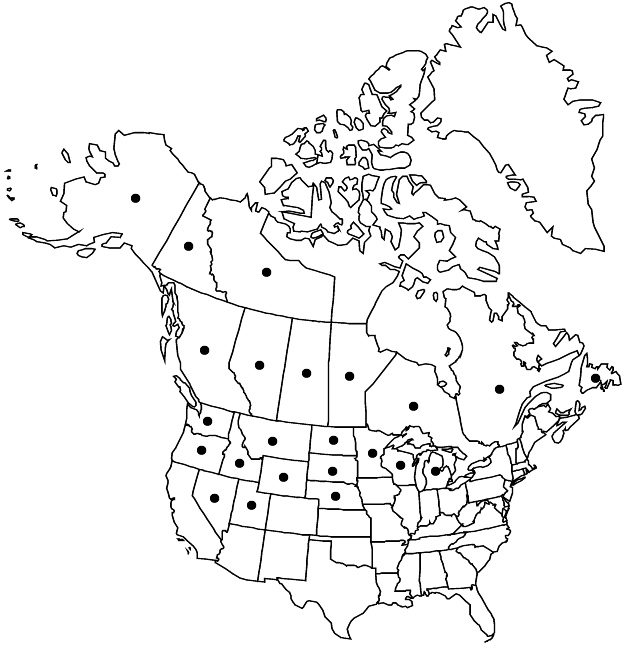Ribes oxyacanthoides
Sp. Pl. 1: 201. 1753 ,.
Plants 0.3–2 m. Stems erect or spreading, strongly puberulent, pubescence often intermixed with glandular hairs, becoming glabrate; spines at nodes 1–3 (–7), 2.2–13 mm; prickles on internodes absent or sparse to dense. Leaves: petiole (0.4–)1–4 cm, finely and softly pubescent, sparsely to densely pubescent, or pilose, and glandular-puberulent or glabrous, sometimes abaxially more glandular, or glabrous; blade roundish to reniform, 3–5(–7)-lobed, cleft 1/2 to midrib, (0.7–)1.5–4 cm, base truncate to cordate, surfaces abaxially pilose to villous, sometimes glabrate or glabrous, stipitate- and sessile-glandular, lobes oblong, oblong-cuneate, or cuneate-rounded, margins irregularly crenate-dentate into prominent, unequal teeth, apex rounded to broadly acute. Inflorescences spreading, solitary flowers or 2–3(–4)-flowered racemes, 2–3 cm, axis glabrous or stipitate-glandular and puberulent to pilose, flowers evenly spaced. Pedicels not jointed, 1–6 mm, glabrous or villous stipitate-glandular and puberulent to pilose; bracts broadly ovate-deltate, 1–2 mm (much shorter than leaves), finely glandular-ciliate. Flowers: hypanthium green or greenish white to white or pinkish, narrowly tubular or campanulate to rotate, 1.4–5.5(–6.6) mm, glabrous abaxially, villous-pubescent adaxially; sepals not overlapping, spreading to somewhat reflexed, greenish white or greenish yellow, sometimes pinkish or purplish with slightly reddish tinge, broadly to narrowly oblong-ovate or elliptic-obovate, 1–6 mm; petals connivent, becoming separated, erect, white or pinkish, oblong-oblanceolate or obovate to oblong-obovate, flabelliform-reniform, or obovate-rhombic, not conspicuously revolute or inrolled, 1–3.5 mm; nectary disc not prominent; stamens as long as or only slightly longer than petals; filaments slightly expanded at base, 0.5–3.5 mm, glabrous; anthers cream, oblong-oval, 0.6–1.3 mm, apex rounded; ovary glabrous; styles connate 1/3–3/4 their lengths, 2.5–8(–9) mm, pilose in proximal 1/2. Berries palatable, reddish, greenish purple, or deep purplish black, globose, 7–16 mm, glabrous.
Distribution

North America.
Discussion
Varieties 5 (5 in the flora).
Selected References
None.
Lower Taxa
Key
| 1 | Styles 2.5-3.3 mm; hypanthia 1.4-3 mm; sepals 1-3.3 mm. | Ribes oxyacanthoides var. hendersonii |
| 1 | Styles 5.5-9 mm; hypanthia 1.5-6.6 mm; sepals 2.5-6 mm | > 2 |
| 2 | Sepals finely pilose. | Ribes oxyacanthoides var. cognatum |
| 2 | Sepals glabrous or with scattered hairs | > 3 |
| 3 | Peduncles 6-15 mm. | Ribes oxyacanthoides var. irriguum |
| 3 | Peduncles 2-6 mm | > 4 |
| 4 | Leaf blades densely pilose abaxially, base truncate or subcordate; sepal apices rounded. | Ribes oxyacanthoides var. oxyacanthoides |
| 4 | Leaf blades finely pubescent abaxially, base deeply cordate; sepal apices truncate. | Ribes oxyacanthoides var. setosum |